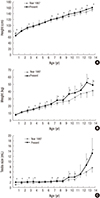1. Reilly JM, Woodhouse CR. Small penis and the male sexual role. J Urol. 1989; 142:569–571.
2. Wiygul J, Palmer LS. Micropenis. ScientificWorldJournal. 2011; 11:1462–1469.
3. Tsang S. When size matters: a clinical review of pathological micropenis. J Pediatr Health Care. 2010; 24:231–240.
4. Kim KS, Han J. Reconstructive surgery for intersex and micropenis. J Korean Soc Pediatr Endocrinol. 2009; 14:1–10.
5. Phillip M, De Boer C, Pilpel D, Karplus M, Sofer S. Clitoral and penile sizes of full term newborns in two different ethnic groups. J Pediatr Endocrinol Metab. 1996; 9:175–179.
6. Chung KH, Choi H, Kim SW. Penile and testicular sizes of Korean children. Korean J Urol. 1987; 28:255–258.
7. Lee JH, Ji YH, Lee SK, Hwang HH, Ryu DS, Kim KS, Choo HS, Park S, Moon KH, Cheon SH, et al. Change in penile length in children: preliminary study. Korean J Urol. 2012; 53:870–874.
8. Park JY, Lim G, Oh KW, Ryu DS, Park S, Jeon JC, Cheon SH, Moon KH, Park S, Park S. Penile length, digit length, and anogenital distance according to birth weight in newborn male infants. Korean J Urol. 2015; 56:248–253.
9. Lee PA, Danish RK, Mazur T, Migeon CJ, Micropenis II. Primary hypogonadism, partial androgen insensitivity syndrome, and idiopathic disorders. Johns Hopkins Med J. 1980; 147:175–181.
10. Khan S, Somani B, Lam W, Donat R. Establishing a reference range for penile length in Caucasian British men: a prospective study of 609 men. BJU Int. 2012; 109:740–744.
11. Ishii T, Matsuo N, Inokuchi M, Hasegawa T. A cross-sectional growth reference and chart of stretched penile length for Japanese boys aged 0-7 years. Horm Res Paediatr. 2014; 82:388–393.
12. Matsuo N, Ishii T, Takayama JI, Miwa M, Hasegawa T. Reference standard of penile size and prevalence of buried penis in Japanese newborn male infants. Endocr J. 2014; 61:849–853.
13. Habous M, Muir G, Tealab A, Williamson B, Elkhouly M, Elhadek W, Mahmoud S, Laban O, Binsaleh S, Abdelwahab O, et al. Analysis of the interobserver variability in penile length assessment. J Sex Med. 2015; 12:2031–2035.
14. Guo LL, Tang DX. Measurement of penile length in children and its significance. Zhonghua Nan Ke Xue. 2013; 19:835–840.
15. Hatipoğlu N, Kurtoğlu S. Micropenis: etiology, diagnosis and treatment approaches. J Clin Res Pediatr Endocrinol. 2013; 5:217–223.
16. Tomova A, Deepinder F, Robeva R, Lalabonova H, Kumanov P, Agarwal A. Growth and development of male external genitalia: a cross-sectional study of 6200 males aged 0 to 19 years. Arch Pediatr Adolesc Med. 2010; 164:1152–1157.
17. Gabrich PN, Vasconcelos JS, Damião R, Silva EA. Penile anthropometry in Brazilian children and adolescents. J Pediatr (Rio J). 2007; 83:441–446.
18. Camurdan AD, Oz MO, Ilhan MN, Camurdan OM, Sahin F, Beyazova U. Current stretched penile length: cross-sectional study of 1040 healthy Turkish children aged 0 to 5 years. Urology. 2007; 70:572–575.
19. Teckchandani N, Bajpai M. Penile length nomogram for Asian Indian prepubertal boys. J Pediatr Urol. 2014; 10:352–354.
20. Cinaz P, Yeşilkaya E, Onganlar YH, Boyraz M, Bideci A, Camurdan O, Karaoğlu AB. Penile anthropometry of normal prepubertal boys in Turkey. Acta Paediatr. 2012; 101:e33–6.
21. Boas M, Boisen KA, Virtanen HE, Kaleva M, Suomi AM, Schmidt IM, Damgaard IN, Kai CM, Chellakooty M, Skakkebaek NE, et al. Postnatal penile length and growth rate correlate to serum testosterone levels: a longitudinal study of 1962 normal boys. Eur J Endocrinol. 2006; 154:125–129.







 PDF
PDF ePub
ePub Citation
Citation Print
Print




 XML Download
XML Download